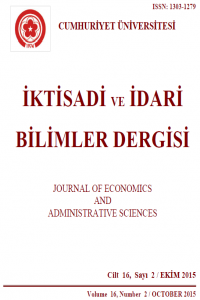Öz
In the Box-Jenkins methodology, ARIMA models are built according to a process that consists of three stages namely specification, estimation and diagnostic checking. Among them the identification stage in which autoregressive and moving average orders of model are determined is the most crucial. In this paper the identification stage mostly based on the subjective decisions has been handled with genetic algorithms. The proposed approach is applied on the producer price index and per capita electric power consumption time series. With this data-driven approach better fitted and also more parsimonious models can be determined. Furthermore, when considering in the context of estimated model number the proposed approach is efficient
Anahtar Kelimeler
Kaynakça
- ABO-HAMMOUR, Za’er S.; Othman M. K. ALSMADI; Adnan M. AL-SMADI; Maha I. ZAQOUT and Mohammad S. SARAIREH (2012), “ARMA Model Order and Parameter Estimation Using Genetic Algorithms.”, Mathematical and Computer Modelling of Dynamical Systems, 18(2); 201–21.
- ABO-HAMMOUR, Za’er S.; Othman M. K. ALSMADI; Shaher MOMANI and Omar ABU ARQUB (2013), “A Genetic Algorithm Approach for Prediction of Linear Dynamical Systems.”, Mathematical Problems in Engineering 2013.
- BALCOMBE, Kelvin G. (2005), “Model Selection Using Information Criteria and Genetic Algorithms.”, Computational Economics, 25(3); 207–28.
- BARAGONA, Roberto and Francesco BATTAGLIA (2009), “Evolutionary Computing in Statistical Data Analysis.” In Foundations of Computational Intelligence Volume 3, Studies in Computational Intelligence, eds. Ajith Abraham, Aboul-Ella Hassanien, Patrick Siarry, and Andries Engelbrecht. Springer Berlin Heidelberg, 347–86.
- BLICKLE, Tobias and Lothar THIELE (1995), “A Mathematical Analysis of Tournament Selection.” Proceedings Of The Sixth International Conference On Genetic Algorithms, 9–16.
- GAETAN, Carlo (2000), “Subset ARMA Model Identification Using Genetic Algorithms.” Journal of Time Series Analysis, 21(5); 559–70.
- MICHALEWICZ, Zbigniew (1996), Genetic Algorithms + Data Structures, Springer.
- MINERVA, Tommaso and Sandra PATERLINI (2002), “Evolutionary Approaches for Statistical Modelling.” In Evolutionary Computation, 2002. CEC ’02. Proceedings of the 2002 Congress, Vol. 2; 2023–2028.
- MINERVA, Tommaso and IRENE Poli (2001), “Building ARMA Models with Genetic Algorithms.” In Applications of Evolutionary Computing, Lecture Notes in Computer Science, ed. Egbert J. W. Boers. Springer Berlin Heidelberg, 335–42.
- NABIYEV, Vasif Vagifoğlu (2005), Yapay Zeka, Seçkin Yayınevi.
- ONG, Chorng-Shyong; Jih-Jeng HUANG and Gwo-Hshiung TZENG (2005), “Model Identification of ARIMA Family Using Genetic Algorithms.”, Applied Mathematics and Computation, 164(3); 885–912.
- SAKAWA, Masatoshi (2002), Genetic Algorithms and Fuzzy Multiobjective Optimization, Springer.
- SATMAN, Mehmet Hakan (2007), “Durağan Zaman Serilerinde Uygun Arma Modelinin Genetik Algoritmalar İle Bulunması ve İMKB Verileri Üzerine Bir Uygulama”, İktisat Fakültesi Mecmuası, 57(1); 21-38.
- SIVANANDAM, S. N. and S. N. DEEPA (2007), Introduction to Genetic Algorithms (1st ed.), Springer.
- YAVUZ, Nilgün Çil (2014), Finansal Ekonometri, Der Yayınları.
Öz
Box-Jenkins yönteminde ARIMA modelleri belirleme, tahmin ve uygunluk testi olmak üzere üç aşamalı bir sürece göre oluşturulmaktadır. Bunlar arasında modelin otoregresif ve hareketli ortalama derecelerinin tespit edildiği belirleme aşaması en kritik olandır. Bu çalışmada büyük ölçüde model kuranın öznel yargılarına dayanan belirleme aşaması genetik algoritmalar çerçevesinde ele alınmıştır. Önerilen yaklaşım üretici fiyat endeksi ve kişi başına elektrik tüketimi serilerine uygulanmıştır. Uygun modelin veriye dayalı olarak seçildiği bu yaklaşım ile daha iyi uyuma sahip olduğu gibi daha az parametre içeren daha cimri modeller belirlenebilmiştir. Ayrıca tahmin edilen model sayısı bağlamında düşünüldüğünde önerilen yaklaşım hesaplama maliyeti bakımından etkindir.
Anahtar Kelimeler
Kaynakça
- ABO-HAMMOUR, Za’er S.; Othman M. K. ALSMADI; Adnan M. AL-SMADI; Maha I. ZAQOUT and Mohammad S. SARAIREH (2012), “ARMA Model Order and Parameter Estimation Using Genetic Algorithms.”, Mathematical and Computer Modelling of Dynamical Systems, 18(2); 201–21.
- ABO-HAMMOUR, Za’er S.; Othman M. K. ALSMADI; Shaher MOMANI and Omar ABU ARQUB (2013), “A Genetic Algorithm Approach for Prediction of Linear Dynamical Systems.”, Mathematical Problems in Engineering 2013.
- BALCOMBE, Kelvin G. (2005), “Model Selection Using Information Criteria and Genetic Algorithms.”, Computational Economics, 25(3); 207–28.
- BARAGONA, Roberto and Francesco BATTAGLIA (2009), “Evolutionary Computing in Statistical Data Analysis.” In Foundations of Computational Intelligence Volume 3, Studies in Computational Intelligence, eds. Ajith Abraham, Aboul-Ella Hassanien, Patrick Siarry, and Andries Engelbrecht. Springer Berlin Heidelberg, 347–86.
- BLICKLE, Tobias and Lothar THIELE (1995), “A Mathematical Analysis of Tournament Selection.” Proceedings Of The Sixth International Conference On Genetic Algorithms, 9–16.
- GAETAN, Carlo (2000), “Subset ARMA Model Identification Using Genetic Algorithms.” Journal of Time Series Analysis, 21(5); 559–70.
- MICHALEWICZ, Zbigniew (1996), Genetic Algorithms + Data Structures, Springer.
- MINERVA, Tommaso and Sandra PATERLINI (2002), “Evolutionary Approaches for Statistical Modelling.” In Evolutionary Computation, 2002. CEC ’02. Proceedings of the 2002 Congress, Vol. 2; 2023–2028.
- MINERVA, Tommaso and IRENE Poli (2001), “Building ARMA Models with Genetic Algorithms.” In Applications of Evolutionary Computing, Lecture Notes in Computer Science, ed. Egbert J. W. Boers. Springer Berlin Heidelberg, 335–42.
- NABIYEV, Vasif Vagifoğlu (2005), Yapay Zeka, Seçkin Yayınevi.
- ONG, Chorng-Shyong; Jih-Jeng HUANG and Gwo-Hshiung TZENG (2005), “Model Identification of ARIMA Family Using Genetic Algorithms.”, Applied Mathematics and Computation, 164(3); 885–912.
- SAKAWA, Masatoshi (2002), Genetic Algorithms and Fuzzy Multiobjective Optimization, Springer.
- SATMAN, Mehmet Hakan (2007), “Durağan Zaman Serilerinde Uygun Arma Modelinin Genetik Algoritmalar İle Bulunması ve İMKB Verileri Üzerine Bir Uygulama”, İktisat Fakültesi Mecmuası, 57(1); 21-38.
- SIVANANDAM, S. N. and S. N. DEEPA (2007), Introduction to Genetic Algorithms (1st ed.), Springer.
- YAVUZ, Nilgün Çil (2014), Finansal Ekonometri, Der Yayınları.
Ayrıntılar
| Birincil Dil | Türkçe |
|---|---|
| Bölüm | Makaleler |
| Yazarlar | |
| Yayımlanma Tarihi | 7 Eylül 2015 |
| Gönderilme Tarihi | 7 Eylül 2015 |
| Yayımlandığı Sayı | Yıl 2015Cilt: 16 Sayı: 2 |
Cumhuriyet Üniversitesi İktisadi ve İdari Bilimler Dergisi Creative Commons Atıf-GayriTicari 4.0 Uluslararası Lisansı (CC BY NC) ile lisanslanmıştır.


